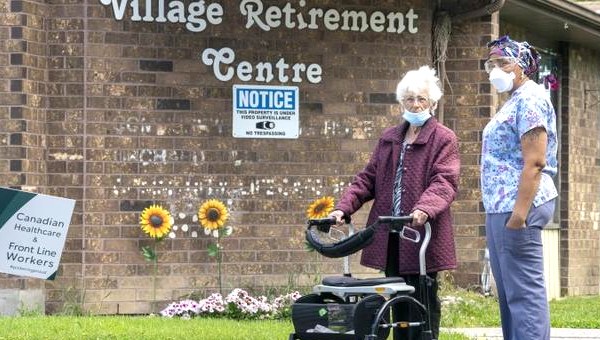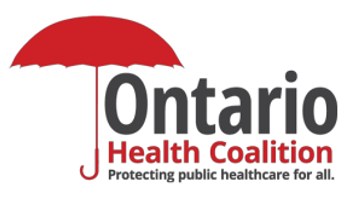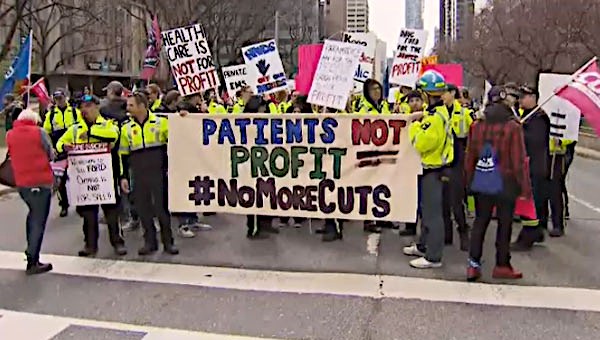Ontario Bill 175 Should Be Scrapped
Ford’s New Home Care Bill Will Compound the Pandemic Disaster
Bill 175 is the new home care law of the Conservative Doug Ford government. It proposes to gut existing home and community care legislation, dismantles public oversight and parcels out currently public home care functions to an array of providers including for-profit companies. Excerpts from The Ontario Health Coalition Submission on Bill 175, Connecting People to Home and Community Care Act 2020 to the Standing Committee on the Legislative Assembly (June 15, 2020) follow.
Bill 175 is so misguided and flawed that it is irredeemable. The process by which this Bill was created was profoundly undemocratic. Key advocacy groups, client representatives, workers’ and health professionals’ representatives were not included in consultations prior to its drafting. The Bill as written reflects the interests and priorities of provider corporations (the majority of which are for-profit) over and against the public interest.

This Bill was rushed through First and Second Reading in the Legislature in ten business days with very little time for stakeholders to learn about its implications and without adequate time for proper parliamentary debate. Yet the Bill has profound implications.
It will result in the wholesale restructuring of home care, the dismantling of much of the existing public governance and oversight, the privatization of existing public and non-profit home care, the creation of a new tier of residential “congregate care,” the potential expansion of private for-profit hospitals, and the privatization of public hospital care, among other major changes. It repeals significant clauses in existing legislation that protect clients’ and the public’s interests in home and community care. It moves all of the key items of governance and democracy, and of public protection and client protections, to regulations that may or may not ever be written and that can be changed by Cabinet without ever going back to the Legislature.
In this way, it takes Ontario’s home and community care backward more than 25 years. It would fragment home care and destabilize the workforce, which already suffers from severe staffing shortages.
There is no justification that would warrant moving forward with this legislation even under normal circumstances. Currently, Ontario is in the midst of the first wave of the COVID-19 pandemic. The last thing that is needed in home care, community care, and hospitals in Ontario is significant destabilization and more privatization. Given the terrible experience of COVID-19 in long-term care homes and other congregate care settings, and in the for-profit homes, in particular, we cannot understand how the government could countenance the expansion of another tier of congregate care without any clarity about the purposes; total permissiveness regarding for-profit privatization; no regulatory, inspections, and enforcement system; and no governance regime.
For all of these reasons, Bill 175 should be withdrawn and a proper consultation process regarding reform of home and community care in the public interest should be undertaken when the pandemic is under control and the context is appropriate.
Dismantling the Public Governance of Home Care
The new regime set out for home and community care in Bill 175 and the summary regulation dismantles most, if not all, public governance of home care. The general thrust of the Bill is to repeal the existing legislation and dismantle the existing governance of home and community care. Almost all of the key aspects of the governance and structures for home and community care are moved out of legislation into regulation that can be changed by Cabinet without ever going back to the Legislature. In this way, the Bill takes us backward more than 25 years.
Under Bill 175 all of the remaining publicly owned and controlled parts of home care would be transferred (in an unspecified time period) to an array of provider organizations including for-profit and non-profit organizations. The legislation is permissive, repealing the previous Home Care and Community Services Act and enabling the provider organizations to structure, contract, subcontract, and run home care in an array of different ways that they would develop themselves.
This reflects what appears to be a trend in major health restructuring legislation by the current government: a “laissez faire” ideology that leaves the planning and governance of vital health care services to provider corporations and organizations without governance structures and with meager oversight, if any. It is not supported by the evidence of the need for democracy, meaningful public input, oversight in the public interest, and protections for patients, residents, and clients who use public health care services. The history of home care in Ontario supports the need for proper governance, organization, clear standards, a principled approach that reflects the values and priorities of Ontarians and that supports equity and compassion.
Under Bill 175, a significant proportion of the organizations that would take over previously publicly controlled home care functions have either no governance and public accountability structure (as in the Ontario Health Teams, OHTs, which are loose coalitions including for-and non-profits that self-govern with no public meetings, no access to information, no elected boards of directors, etc.) or are private (as in private for-profit home care companies) or are non-profit with often limited memberships and little public accountability. There are a small minority of non-profit agencies left in home care that are actually community-based and democratic. In this legislation, private chain corporations who are poised and have a vital interest in expanding their market share and profits would be given opportunity to take over more control of home and community care, and the control over home care from top to bottom would be unaccountable, without any of even the normal public protections and governance.
The Bill and summary regulation also reach beyond home and community care to expand residential congregate care, with no clear definition that limits what services this might include, posing a risk to existing standards for long-term care and even hospital care. The summary regulation also includes a list of current public hospital services in the range of services that would be moved under the desultory or non-existent governance and regulatory regime it sets up. The Bill itself enables private for-profit hospitals to expand for the first time since the formalization of the public hospital system in Ontario.
We must warn the government in the strongest possible terms that we will do everything in our power to stop the expansion of private for-profit home and community care, privatization of hospital care, and the expansion of private for-profit congregate care. If Ontarians have learned anything from COVID-19, it is that we cannot allow governments to continue to privatize health care at the behest of self-interested for-profit companies.
OHC’s Key Concerns
1. The new regime set out for home and community care dismantles most, if not all, public governance of home care. All of the remaining publicly owned and controlled parts of home care would be transferred (in an unspecified time period) to an array of provider organizations including for-profit organizations. The legislation is permissive, repealing the previous Home Care and Community Services Act, including vital public interest protections, and moves all of the governance and structures of home care into regulations. It enables the provider organizations to structure, contract, subcontract, and run home care in an array of different ways that they would develop themselves. A significant proportion of the organizations that would take over previously publicly controlled home care functions either have no governance and public accountability structure (as in the Ontario Health Teams (OHTs) which are loose coalitions including for-and non-profits that self-govern with no public meetings, no access to information, no elected boards of directors, etc.) or are private (as in private for-profit home care companies) or are non-profit with often limited memberships and little public accountability. There are a small minority of non-profit agencies left in home care that are actually community-based and democratic.
For clarity, under the proposed legislation and regulation, the following changes would happen:
a. The Super Agency, now called Ontario Health, would take over funding home and community care services from the Local Health Integration Networks (LHINs). The Super Agency (Ontario Health) is governed by a Board that is not subject to the Ontario public service legislation regarding conflict of interest. The majority of Board members come from private industries such as banks, financial corporations including REITs, pro-privatization organizations, private consulting firms, and for-profit long-term care, among others. Ontario Health has no regulations for public input, open board meetings, public access to information, and even less democratic protections than the LHINs.
b. The power to contract home care services (and apparently placement coordination functions) currently held by the LHINs would be handed off to an array of different organizations that are not publicly governed and accountable. These can include non-profit agencies, the Ontario Health Teams (which are loose coalitions without any public governance structures and include for-profit and non-profit companies) and primary care providers (most of which do not have public governance and accountability structures). The LHINs, which we advocated to be reformed to make them more public and accountable, not less, are Crown Agencies, set up as public entities and operated on a non-profit basis.
c. The care coordination functions of the LHINs would be contracted by these organizations to provider home care companies (majority for-profit) or to unnamed third parties.
d. The LHINs will be renamed and continued on an “interim” basis until home care is transferred on a phased and gradual basis to the Ontario Health Teams or Health Service Providers.
This change means that significant and vital parts of home care could be privatized, including transfer of control from publicly-controlled LHINs to the Ontario Health Teams, which are loose coalitions that include for-profit companies, and transfer of care coordination functions to an array of provider companies that are dominated by for-profit chains.
This plan is chaotic. It would mean that home care will be governed by different entities in different regions according to different models. The plan would enable this array of different providers to structure and contract home care themselves. The Ontario Health Teams have no governance provisions. Not all of Ontario is covered by them. They are all different and it is uncertain how they will work. The first set are just getting started. This model does not “integrate” home care. It dismantles all existing public governance and devolves it to an array of service providers with very different cultures, motives, capacities, and governance models (or no governance model).
This proposal would enable for-profit corporations to both coordinate care and be the providers of that care. This means that they themselves determine how many visits a person can have, how many supplies and resources are allotted to them, and how they supervise their own care. Already missed visits and non-fulfillment of contracts is a major longstanding problem for home care clients, compromising their care and safety. This is a conflict of interest, and it is not in the public interest.
Recommendation: These Sections of the Bill and the attendant proposals in the regulation summary should be removed.
5. Among the changes proposed is a provision to send privatized home care into public hospitals.
Recommendation: This proposal in the regulation should be removed.
6. The proposal includes expansion of the new regime to cover Aphasia services, Pain and symptom management, Diabetes education, and Psychological services for persons with acquired brain injuries.
Recommendation: This proposal in the regulation should be removed.
7. The proposal includes the creation of a new tier of unlicensed residential services without any public-interest protections, and no protections against downloading and erosion of existing protections in hospital and long-term care. If this proposal were to expand the provision of supportive housing and was clearly defined as this, it would be welcome. However, it is undefined (and unlimited) in the proposed regulation and, therefore, poses a significant threat of erosion of already insufficient care levels for Ontarians who are trying to access chronic-care and long-term care. Of concern is that instead of increasing care levels for our elders and vulnerable people, this tier would actually lower them.
Recommendation: This proposal in the regulation should be removed.
8. The proposal includes provision for the expansion of private for-profit hospitals into these and other residential-care services (including, potentially, services that are provided by public hospitals and by long-term-care homes). It is not in the public interest to expand private for-profit hospitals.
Recommendation: This Section in the Bill should be removed.
9. The proposal removes a host of existing public interest protections under the Home Care and Community Services Act and does not improve on existing provisions regarding access and eligibility, out-of-pocket costs, expansion of virtual home care without patient protections, and others. Vital sections of the existing Home and Community Services Act are repealed including the Bill of Rights; the ability of the Minister to enforce the Bill of Rights; the ability of the Minister to not approve an agency based on financial record, enforcement of the Bill of Rights, and other public interest protections; the governance of complaints from clients; requirements of providers to put clients on the wait list if services are not currently available; and others.
These are important public protections that belong in legislation. There is nothing in the new plan that provides any better protections for home care clients regarding access to care, assessments that do not measure actual need, rationing of home care, inequities from region to region, missed visits, and other major problems in home care.
Recommendation: These Sections of the Bill and attendant proposals in the summary regulation should be removed. Better public interest protections regarding response to complaints, access, and eligibility should be instituted.
10. The proposal moves most of the key elements of home care governance out of legislation and into regulation which can be changed at any time without going back to the Legislature and without any meaningful public input.
Recommendation: These Sections of the Bill should be removed.
11. The process by which these dramatic changes are being made has been profoundly undemocratic. The majority, if not all, public interest voices have been excluded from consultations prior to the drafting of this legislation. The Bill was rushed through First and Second Reading in the Legislature in only ten business days. This is unprecedented. The public hearings are occurring during a pandemic, with short public notice. The process is unacceptable and has resulted in legislation that is poorly conceived and reflects private for-profit interests over and against the public interest.
Recommendation: A proper public consultation process that is equitable and that does not disproportionately favour industry representatives over client, public interest, and worker voices could have led to draft legislation that reflects the public interest rather than provider corporations’ interests. When the context is appropriate, the government should start a proper public consultation process on reforming home care in the public interest.
Overall Recommendation: This legislation should be withdrawn.
Privatization and Disintegration of Hospital Care
In the new regulation, the government is proposing that home care provide services in public hospitals for complex clients. This is potentially a violation of the Canada Health Act (under which patients have the right to needed hospital care without user charges and extra billing including meals, accommodations, nursing care, and other care required during their hospital stay). Moreover, hospitals are funded for and are responsible for the care of people in their hospitals and employ a workforce to provide this care. It is not clear what scope of services the government would have contracted out to home care companies for hospital patients. This raises serious questions about liability, management, dis-integration of care, continuity and quality of care, privatization, funding, and more. Conversely, the government is proposing to maintain the ban on home care going in to long-term care homes to provide care which is already funded through long-term care funding.
a. Privatization/downloading of transitional care beds, rehabilitation beds, and long-term care
The proposed regulation includes a provision for new non-licensed residential “congregate care” models for patients who “do not require the intensity of resources provided in a hospital or long-term care home, but whose needs are too high to be cared for at home.” This could include transitional or rehabilitative care over longer periods of time, to be defined in regulation. There is currently no definition in law for transitional beds. Rehabilitation beds are supposed to be covered under the Canada Health Act. This regulation could also include many types of residents who currently receive more care through long-term care homes. Both hospital and long-term care are severely rationed in Ontario (Ontario has the fewest hospital beds of any province and the second fewest long-term care beds. Wait lists are extremely long for long-term care. Prior to COVID-19, overcrowding has routinely been at crisis levels in hospitals). Already, acuity levels (complexity and heaviness of care needs) among residents in long-term care is very high, often dangerously high, and inadequate to meet the needs of residents.

It is of deep concern that this second tier of unlicensed and potentially unregulated care be used to further download patients into lower (and cheaper) levels of care. This section raises the spectre of private for-profit retirement homes (many owned by for-profit long-term care chains) expanding a tier of unlicensed unregulated long-term care with public funding (which is now banned for retirement homes which are not health care facilities and are not regulated). Unregulated settings put people at risk. Combined with the proposed amendment to the Private Hospitals Act, it also raises the spectre of for-profit hospitals or other for-profit entities expanding into this area. There is also a distinct threat that categories of long-term care residents will be forced into facilities that provide much less care. A plan to expand supportive living environments for the frail elderly to live independently would be welcome but that is not what this section of the proposed regulation states.
b. Expansion of virtual home care without protections for patients
The regulation proposes the expansion of the use of “virtual visits.” In the description of the regulation they state that the regulatory amendment that came into force January 1, 2020, clarifies that services may be delivered virtually using electronic means. They are proposing to continue to allow this “if appropriate and based on the assessed needs and preferences of the patient” but there is nothing in the regulatory proposal that protects the patient’s right to express and have their preferences listened to. The record of assessing needs in home care is already very poor, and there are frequent complaints about it. The ability for companies to save money and increase their profits by denying patients real home care visits and replacing them with “virtual” check ins is not in the public interest and not in patients’ interests. Consumer advocates report they are concerned about the costs and maintenance of equipment needed for virtual care; that there need to be protocols and infrastructure to support it and someone available to fix it if something goes wrong. Overall, there need to be robust patient/client protections around this, but such protections are neither in the existing regulation nor in the proposal.
c. No improvement to eligibility for home and community care
The Ministry is proposing to maintain the existing eligibility criteria for services as outlined in regulation 386/99. However, there is no positive right to access home care (such as the right to hospital and physician care under the Canada Health Act), only prohibitions on eligibility in certain circumstances (e.g., residents of long-term care homes whose daily care is already covered under funding to the long-term care home). This has been a consistent problem, and it means that rationing will continue based on funding. What rationing currently looks like is this: people may access all the publicly funded home care services they need, usually for short periods of time; people may access some publicly funded home care services they need and are required to pay for the rest even if they cannot afford them (in which case, they go without), or; people cannot access any publicly funded home care services despite need and must either pay privately or go without.
The Minister has stated that the government will remove service caps (maximum number of hours of service). On the surface, this sounds positive. However, in reality, all public relations statements about removing service caps are relatively meaningless, since care is rationed by inadequate funding. Already, the regulation provides for exceptions to the service caps for people with high needs, those waiting for long-term care, and the dying. People still do not have adequate care because care is rationed by inadequate funding levels. Without a positive right to access care, people needing home care cannot even get onto a wait list; they are simply denied services. (For example, for many years, everyone whose needs were assessed as medium or below were denied access in various CCACs/LHINs because all of the home care resources were taken by people whose care needs were determined to be high. They could not even get onto a wait list. They were simply told that they were not eligible.)
The current regulatory regime for charging user fees to patients for services will continue. People who are deemed to be eligible for home care (with all the inadequacies that currently exist as outlined above) will receive a range of services that are publicly funded that may or may not meet their level of need, and people will be deemed ineligible based on rationing.
On a positive note, according to the summary regulation, the government is considering allowing eligibility for pharmacy and physiotherapy services if there is nothing available in their region or in their local community. (No details provided.)
d. Home and Community Care Bill of Rights moved out of legislation to regulation
With the repeal of the Home Care and Community Service Act 1994, the Bill of Rights for home and community care clients would be repealed. The proposed regulation states that the Ministry intends to create a new Bill of Rights under the new regulation (not in legislation), which means it could be changed without any meaningful public input as noted above.
e. Complaints and Appeals moved out of legislation to regulation
The specific wording of the proposed regulation summary refers to continuing the requirements in Regulation 386/99 for a process for reviewing complaints and the list of complaint topics in the regulation (but not the legislation). It appears this is a typographical error. In the 1994 Act, there is a list of complaint topics (similar to those listed in the new proposed regulation summary) and timelines within which they need to be responded to, as well as a process for appeals. The proposed new regulation would move these requirements to regulation and says that they will continue to be similar, though they could be changed easily in the regulation without any meaningful public input as noted above. The same analysis applies to Appeals. •





